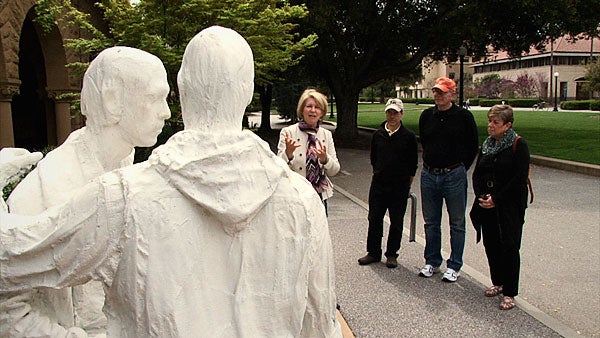|
View video here.
April 25, 2012
Stanford's distinguished outdoor art collection is on view 365 days a year
Cantor Arts Center's highly trained docents lead guided tours of the outdoor collection. By Robin Wander

Docent Gretchen Ostenberg explains the materials used in George Segal's sculpture Gay Liberation. (Photo: Steve Fyffe / Stanford News Service) Viewing art is a personal thing. Some like labels, some don't. Some want the backstory, some want to be surprised. To be led, or not to be led? That is often the question, and for those who appreciate knowledgeable insight and conversation while viewing art, the answer is to be led.
The next several months promise nearly picture-perfect weather for being led through Stanford's outdoor collection.
Stanford's Cantor Arts Center offers a variety of docent-led tours of its distinguished art collections. One of the most popular is the outdoor sculpture walk on the first Sunday of the month. This tour meets – rain or shine – at 2 p.m. at the top of the Oval.
Starting in the Main Quad, you can walk on your own in any direction for 10 minutes and see at least a half dozen works of art. Give a docent an hour and a half and you will see 15-20 works and be all the wiser.
The docents are knowledgeable about each of the 100 or so pieces in the outdoor collection, but they select a small group to focus on for each outdoor sculpture walk. "You could take the outdoor sculpture walk repeatedly and discover new works each time, and return to known works from a different thematic vantage point each time," said Patience Young, the curator of education. "Docents are prepared to accommodate visitors' interests and inquiries, so there's a lot of flexibility within any tour."
There are different tours on different days that focus exclusively on the Rodin collection and the Papua New Guinea Sculpture Garden.
The outdoor art collection spans more than 100 years with the oldest pieces dating from Leland and Jane Stanford's time. An early example is Antonio Frilli's Faith and Menander, c. 1890; the Auguste Rodin works date from 1880-1900. Contemporary works include Bruce Beasley's bronze Horizon II, 2006, and the plant installation titled The California Garden, 2002-2003, by Meg Webster.
A must-see work on the first-Sunday tour is Rodin's Burghers of Calais, 1884-1885. Docents report that this piece generates a lot of discussion.
33-week basic training for docents
The Cantor Arts Center docents are all volunteers and function as an extension of the museum's education department. The current docent corps at the Cantor includes about 60 active volunteers, some of whom have been with the program for more than 30 years.
Basic training for incoming docents is held every three years and runs parallel to the academic year, September to June. Class meets two days a week for 33 weeks and includes outside reading assignments, tour observations and practice-tours with selected tour groups. The next class of docents is scheduled to start in September 2013.
Training is collaboratively planned and taught by a team of Cantor Arts Center curators, staff and volunteers led by Rose Demir, the associate curator for education. A typical docent class has about 20 trainees who apply the previous winter/spring and are notified in June.
Basic training and its final individual tour-exam qualify a docent to give introductory tours at the Cantor Arts Center for groups of all ages. Docents giving the outdoor sculpture tour are well-established in the docent program and have participated in specific training sessions over several weeks in order to speak authoritatively about the outdoor collection.
"We are quite proud of our current basic training, which has evolved over time to build strength in interactive discussions linking visitors to artworks that may be meaningful to them," said Young. "A team of our docents presented our program at the biennial National Docent Symposium in St. Louis last October, and we consider this program to be a leading model for art museum educators elsewhere."
Different days, different tours
The outdoor sculpture installed on museum grounds, and in one case across the street from the museum, can be explored with a docent the third Sunday of each month at 11:30 a.m. This tour begins in front of the Cantor Arts Center with marble pieces dating from 1891 and continues with the works of Auguste Rodin, Beverly Pepper, Mark di Suvero and, most recently, Andy Goldsworthy.
For a more focused tour of one of the largest collections of Rodin's work outside of Paris, meet on Wednesdays at 2 p.m., Saturdays at 11:30 a.m. or Sundays at 3 p.m. in the museum lobby. The B. Gerald Cantor Rodin Sculpture Garden on the south side of the museum features 20 bronzes by Auguste Rodin, including The Gates of Hell. The Cantor Arts Center also has three indoor galleries dedicated to the work of Rodin, which are part of the tour.
Finally, across campus at Santa Teresa Street and Lomita Drive is the Papua New Guinea Sculpture Garden, containing 40 wood and stone carvings of people, animals and magical beings that illustrate creation stories and cultural traditions. Ten artists from the inland Sepik River region of Papua New Guinea created the sculptures on-site during a five-month visit. The garden opened in 1996. The garden is always open and docent-led tours are on the third Sunday of the month at 2 p.m.
Prefer to tour on your own? A map of the outdoor sculpture on campus is available at the Cantor Arts Center and can be downloaded. Also, a walking tour podcast of new sights on campus, including buildings, gardens and art, is available on Stanford on iTunes U.
-30-
|